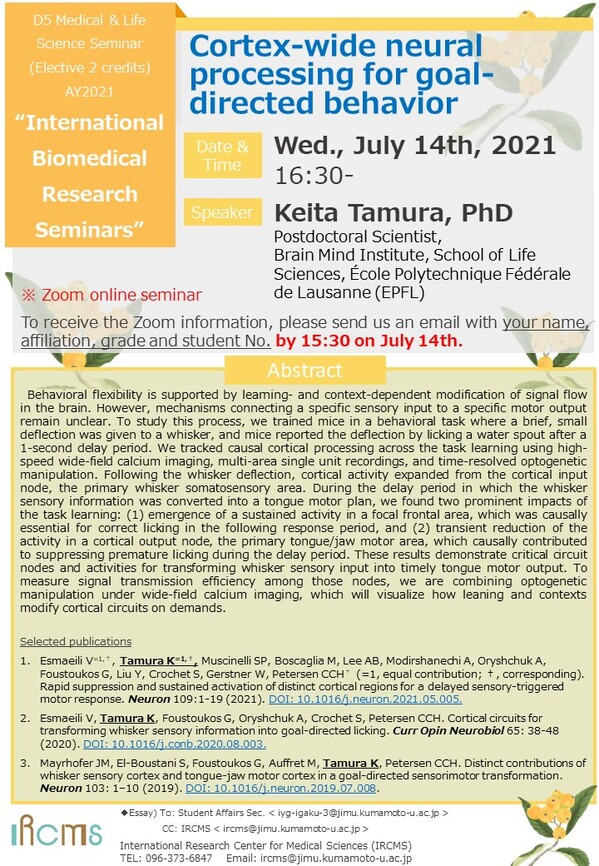- HOME
- News & Events
- [July 14] D5 Medical & Life Science Seminar-Dr. Keita Tamura
News & Events
[July 14] D5 Medical & Life Science Seminar-Dr. Keita Tamura
June 23 2021
The "D5 Medical & Life Science Seminar" course will be offered by International Research Center for Medical Sciences (IRCMS). It will run from April 2021 to March 2022, with lectures given by scientists who are affiliated with IRCMS or in collaboration with researchers at IRCMS. The lectures will be given once a month, in English, and by leading scientists in the relevant research field. Students will be taught: 1) how normal physiological functions are maintained in the human body; 2) how these systems become abnormal under certain pathophysiologic conditions; 3) why stem cells are important in animal development and homeostasis; 4) how stem cell-based approaches can help us understand disease mechanisms and find potential cure for diseases related to stem cell malfunction (e.g., cancer, aging).
Date : July 14, 2021 (Wednesday)
Time : 16:30 -
* Zoom online seminar
|
To receive the meeting ID / Password, please send an email to |
Speaker : Keita Tamura, PhD
Postdoctoral Scientist,
Brain Mind Institute, School of Life Sciences,
École Polytechnique Fédérale de Lausanne (EPFL)
Title : Cortex-wide neural processing for goal-directed behavior
Abstract :
Behavioral flexibility is supported by learning- and context-dependent modification of signal flow in the brain. However, mechanisms connecting a specific sensory input to a specific motor output remain unclear. To study this process, we trained mice in a behavioral task where a brief, small deflection was given to a whisker, and mice reported the deflection by licking a water spout after a 1-second delay period. We tracked causal cortical processing across the task learning using high-speed wide-field calcium imaging, multi-area single unit recordings, and time-resolved optogenetic manipulation. Following the whisker deflection, cortical activity expanded from the cortical input node, the primary whisker somatosensory area. During the delay period in which the whisker sensory information was converted into a tongue motor plan, we found two prominent impacts of the task learning: (1) emergence of a sustained activity in a focal frontal area, which was causally essential for correct licking in the following response period, and (2) transient reduction of the activity in a cortical output node, the primary tongue/jaw motor area, which causally contributed to suppressing premature licking during the delay period. These results demonstrate critical circuit nodes and activities for transforming whisker sensory input into timely tongue motor output. To measure signal transmission efficiency among those nodes, we are combining optogenetic manipulation under wide-field calcium imaging, which will visualize how leaning and contexts modify cortical circuits on demands.
Selected publications:
- Esmaeili V=1,†, Tamura K=1,†, Muscinelli SP, Boscaglia M, Lee AB, Modirshanechi A, Oryshchuk A, Foustoukos G, Liu Y, Crochet S, Gerstner W, Petersen CCH† (=1, equal contribution; †, corresponding). Rapid suppression and sustained activation of distinct cortical regions for a delayed sensory-triggered motor response. Neuron 109:1-19 (2021). DOI: 10.1016/j.neuron.2021.05.005.
- Esmaeili V, Tamura K, Foustoukos G, Oryshchuk A, Crochet S, Petersen CCH. Cortical circuits for transforming whisker sensory information into goal-directed licking. Curr Opin Neurobiol 65: 38-48 (2020). DOI: 10.1016/j.conb.2020.08.003.
- Mayrhofer JM, El-Boustani S, Foustoukos G, Auffret M, Tamura K, Petersen CCH. Distinct contributions of whisker sensory cortex and tongue-jaw motor cortex in a goal-directed sensorimotor transformation. Neuron 103: 1-10 (2019). DOI: 10.1016/j.neuron.2019.07.008.
Flyer: (Click for a larger image)

